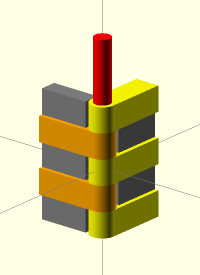VdW suck-in
Van der Waals force can be very useful in advanced gemstone based nanosystems to hold things in place
- during assembly processes or
- even in final products.
In particular the VdW force can be uses to hold axles withing chains.
Axles literally get "sucked" into their sleeves as the higher surface contact area means lower energy.
This is very similar to surface tension energy.
So unlike a (hooks law) linear spring where force is proportional to displacement
one gets a near constant force over displacement.
By choosing contact area profiles (easier for planar surfaces) one can emulate all kind on nonlinear spring behaviors.
- (wiki-TODO: Add image of extendable soap bubble skin in rectangular wireframe)
- (wiki-TODO: Add math showing that at room-temperature thermally activated axle displacements are negligible even for very small crystolecules)
Contents
A note on sticking strength
The strength of VdW bonds is not to be underestimated.
Weak bonds can be shaken open by thermal motion from heating. But ...
It does not take much contact surface area at all such that
the required temperature would be so high that
the gemstone base material would start to melt (or decompose) before the contact sticking becomes shaken apart.
Much boosted by the situation that the wole crystolecule made from many many atoms
does just get kT energy for each of it's few DOFs of motion.
- (wiki-TODO: Make a temperature vs area chart for diamond to diamond planar contact)
Estimating thermally driven slide-out quantitatively
Let's assume a pin with a diameter of ⌀1nm:
From Nanosystems we know that the
VdW-energy surface-energy-density between diamonds is
ε = 200zJ/nm² (for silicon instead it is: ε = 700zJ/nm²)
Question: What is the expectation for the
axial slide-out h corresponding to E = k * 300K?
d * π * h * ε = k T
h = k T / (d * π * eps)
h = 4.14zJ / (1nm * π * 200zJ/nm^2)
h = 6.6pm (crudely!)
Van der Waals alone is more than sufficient.
Even for smallest axles and all nondestructive temperatures.
Tenfold room temperature in Kelvin (300K => 3000K) still
gives only a mere 66pm expectation for the slide-out distance.
For reference the length of a (C–C) bond in diamond is 154pm.
Even short pins will be significantly longer.
Related
- Van der Waals force sticking - (wiki-TODO: fator parts out to this page)
- Van der Waals force
- Energy, force, and stiffness
- Comparison of mechanical character of different bonds types
- Intuitive feel
- Crystolecules
External links
Surface tension is a good intuition for sliding type VdW forces:
Here's a short video on YouTube @FluidDynamics
Here's another longer video demo on youtube @fyzlab.
Note that in the video due to the small area and large relative area change the membrane gets thinned out by a lot
this leads to a non-constant increasing force and rather than a constant force
which in turn allows for balancing with the constant force that is gravity.
VdW force on the other hand has no such thinning out effect and is constant.
- Wikipedia: Surface tension
- Wikipedia: growing surface graphic
- Tweet about related math: https://twitter.com/mechadense/status/1529798765854564352?s=20&t=CM0IGEpcOo67KRC3eG7dMA
